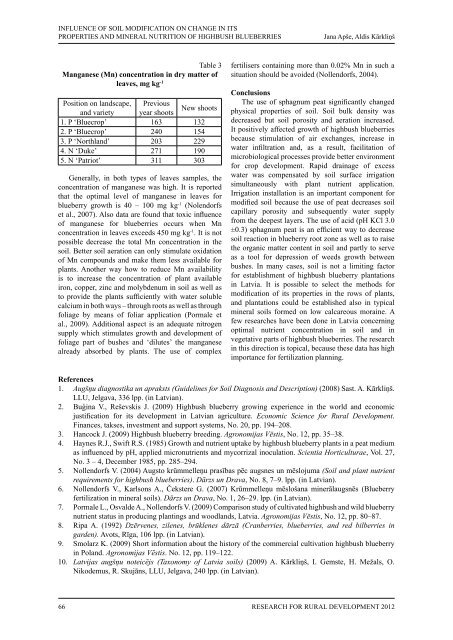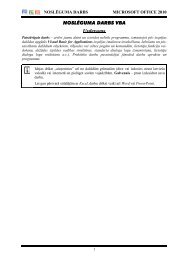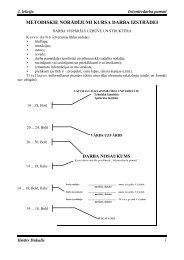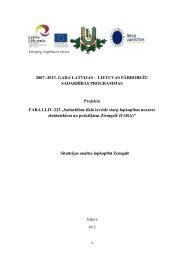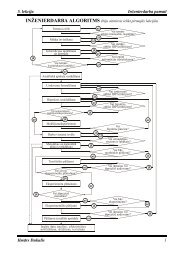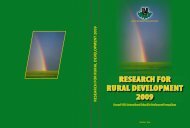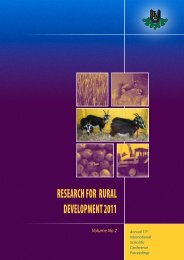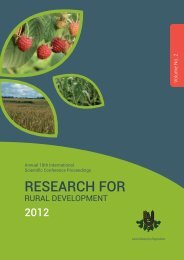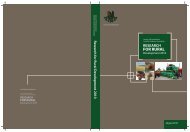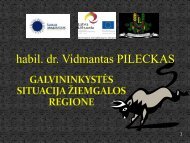LATVIA UNIVERSITY OF AGRICULTURE - Latvijas ...
LATVIA UNIVERSITY OF AGRICULTURE - Latvijas ...
LATVIA UNIVERSITY OF AGRICULTURE - Latvijas ...
- No tags were found...
Create successful ePaper yourself
Turn your PDF publications into a flip-book with our unique Google optimized e-Paper software.
INFLUENCE <strong>OF</strong> SOIL MODIFICATION ON CHANGE IN ITSPROPERTIES AND MINERAL NUTRITION <strong>OF</strong> HIGHBUSH BLUEBERRIESJana Apše, Aldis KārkliņšTable 3Manganese (Mn) concentration in dry matter ofleaves, mg kg -1Position on landscape, Previousand variety year shootsNew shoots1. P ‘Bluecrop’ 163 1322. P ‘Bluecrop’ 240 1543. P ‘Northland’ 203 2294. N ‘Duke’ 271 1905. N ‘Patriot’ 311 303Generally, in both types of leaves samples, theconcentration of manganese was high. It is reportedthat the optimal level of manganese in leaves forblueberry growth is 40 – 100 mg kg -1 (Nolendorfset al., 2007). Also data are found that toxic influenceof manganese for blueberries occurs when Mnconcentration in leaves exceeds 450 mg kg -1 . It is notpossible decrease the total Mn concentration in thesoil. Better soil aeration can only stimulate oxidationof Mn compounds and make them less available forplants. Another way how to reduce Mn availabilityis to increase the concentration of plant availableiron, copper, zinc and molybdenum in soil as well asto provide the plants sufficiently with water solublecalcium in both ways – through roots as well as throughfoliage by means of foliar application (Pormale etal., 2009). Additional aspect is an adequate nitrogensupply which stimulates growth and development offoliage part of bushes and ‘dilutes’ the manganesealready absorbed by plants. The use of complexfertilisers containing more than 0.02% Mn in such asituation should be avoided (Nollendorfs, 2004).ConclusionsThe use of sphagnum peat significantly changedphysical properties of soil. Soil bulk density wasdecreased but soil porosity and aeration increased.It positively affected growth of highbush blueberriesbecause stimulation of air exchanges, increase inwater infiltration and, as a result, facilitation ofmicrobiological processes provide better environmentfor crop development. Rapid drainage of excesswater was compensated by soil surface irrigationsimultaneously with plant nutrient application.Irrigation installation is an important component formodified soil because the use of peat decreases soilcapillary porosity and subsequently water supplyfrom the deepest layers. The use of acid (pH KCl 3.0±0.3) sphagnum peat is an efficient way to decreasesoil reaction in blueberry root zone as well as to raisethe organic matter content in soil and partly to serveas a tool for depression of weeds growth betweenbushes. In many cases, soil is not a limiting factorfor establishment of highbush blueberry plantationsin Latvia. It is possible to select the methods formodification of its properties in the rows of plants,and plantations could be established also in typicalmineral soils formed on low calcareous moraine. Afew researches have been done in Latvia concerningoptimal nutrient concentration in soil and invegetative parts of highbush blueberries. The researchin this direction is topical, because these data has highimportance for fertilization planning.References1. Augšņu diagnostika un apraksts (Guidelines for Soil Diagnosis and Description) (2008) Sast. A. Kārkliņš.LLU, Jelgava, 336 lpp. (in Latvian).2. Buģina V., Reševskis J. (2009) Highbush blueberry growing experience in the world and economicjustification for its development in Latvian agriculture. Economic Science for Rural Development.Finances, takses, investment and support systems, No. 20, pp. 194–208.3. Hancock J. (2009) Highbush blueberry breeding. Agronomijas Vēstis, No. 12, pp. 35–38.4. Haynes R.J., Swift R.S. (1985) Growth and nutrient uptake by highbush blueberry plants in a peat mediumas influenced by pH, applied micronutrients and mycorrizal inoculation. Scientia Horticulturae, Vol. 27,No. 3 – 4, December 1985, pp. 285–294.5. Nollendorfs V. (2004) Augsto krūmmelleņu prasības pēc augsnes un mēslojuma (Soil and plant nutrientrequirements for highbush blueberries). Dārzs un Drava, No. 8, 7–9. lpp. (in Latvian).6. Nollendorfs V., Karlsons A., Čekstere G. (2007) Krūmmelleņu mēslošana minerālaugsnēs (Blueberryfertilization in mineral soils). Dārzs un Drava, No. 1, 26–29. lpp. (in Latvian).7. Pormale L., Osvalde A., Nollendorfs V. (2009) Comparison study of cultivated highbush and wild blueberrynutrient status in producing plantings and woodlands, Latvia. Agronomijas Vēstis, No. 12, pp. 80–87.8. Ripa A. (1992) Dzērvenes, zilenes, brūklenes dārzā (Cranberries, blueberries, and red bilberries ingarden). Avots, Rīga, 106 lpp. (in Latvian).9. Smolarz K. (2009) Short information about the history of the commercial cultivation highbush blueberryin Poland. Agronomijas Vēstis. No. 12, pp. 119–122.10. <strong>Latvijas</strong> augšņu noteicējs (Taxonomy of Latvia soils) (2009) A. Kārkliņš, I. Gemste, H. Mežals, O.Nikodemus, R. Skujāns, LLU, Jelgava, 240 lpp. (in Latvian).66 Research for Rural Development 2012


